Welcome, pilots! Before you begin, note that this article is intended to introduce the X-Wing Miniatures Game to brand-new players, and provide some guidance on how to get started. It is not intended as a how-to-play or tactics article, so abandon ship now if you are an experienced player seeking that information. If you are new and X-Wing curious, or looking to get back into this fantastic game after a hiatus – please proceed and enjoy!
Is X-Wing For Me?
Do your favorite Star Wars movie scenes include the iconic trench run in A New Hope, the climactic assault on the second Death Star over Endor, the cat-and-mouse asteroid chase between Obi-Wan and Jango Fett in Attack of the Clones, or the dazzling opening battle over Coruscant in Revenge of the Sith?
Did your childhood involve the X-Wing vs. TIE Fighter video game series, swooshing Action Fleet toys through the air, reading the X-Wing novel series, or goggling at the Rogue Squadron comics? Or more recently, have you had a blast playing Star Wars: Squadrons?
Does this Danger Zone video really get you going?
If you answered “yes” to any of the questions above, and love the idea of a Star-Wars-meets-Top-Gun gaming experience, the X-Wing Miniatures Game is for you.
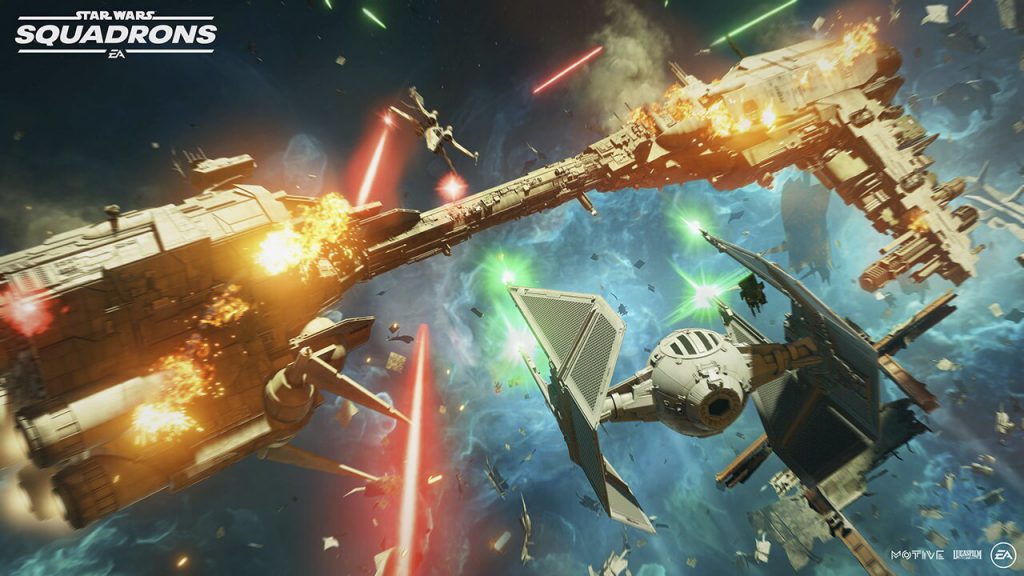
How Would You Describe X-Wing?
It is a fast-paced game of baiting, bluffing, maneuvering, and careful stress management. The mechanics convey flow and momentum, with ships moving in looping arcs and hairs-breadth barrel rolls completely unlike the movement seen in most miniature games. The use of curved templates for movement combined with the inability to pre-measure results in spectacular asteroid collisions and “whoop-with-relief” near-misses, making the maneuvering phase just as exciting as the shooting phase.
Each ship type is imbued with incredible personality thanks to chassis-specific maneuver dials and actions – you’ll see the clunky workhorse Y-Wing, zippy but fragile A-Wing, brutally offensive B-Wing, and eponymous all-rounder X-Wing among many others (the Rebel faction alone has 21 ship types available at the time of writing).
Importantly for people who don’t have a large wargaming social circle, the game itself straddles the line between board game and miniature game. It has enough complexity to keep miniature wargamers happy, but the core rules are approachable enough that you can introduce it to board-gaming friends or bring it to a casual game night. Using my wife as an example, she won’t touch Warhammer 40,000, Necromunda, or Kill Team – but she loves X-Wing, to the point of insisting we attend local organized play events together!
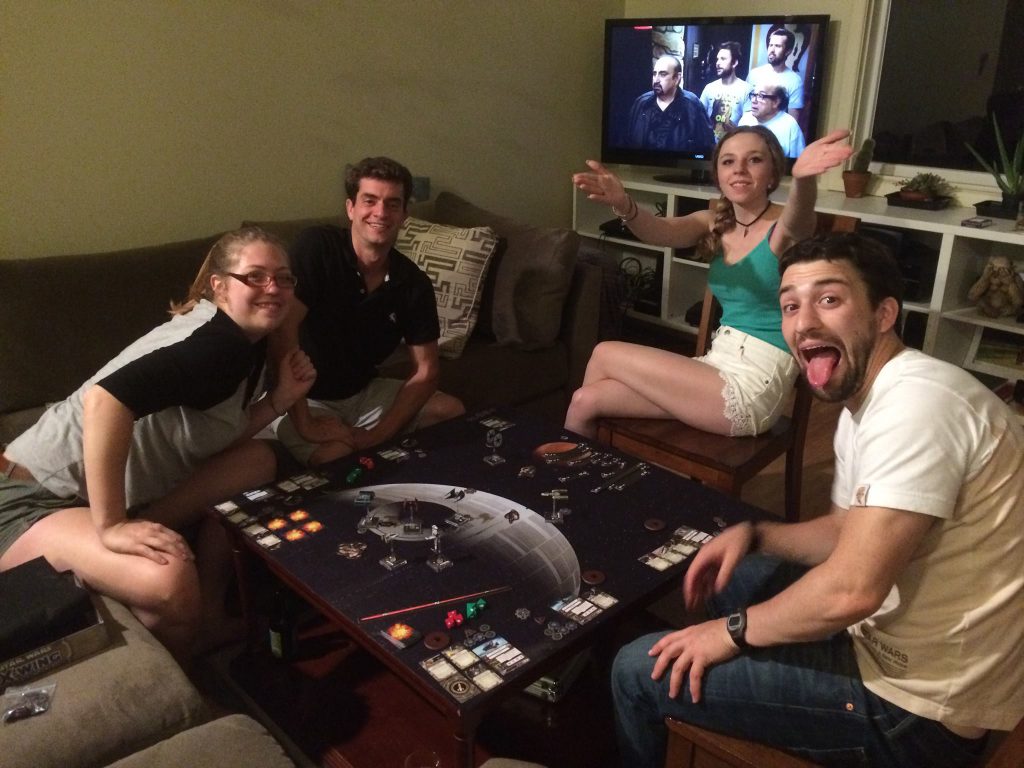
I’m Not Sure I Have The Bandwidth For A New Game…
X-Wing is among the cheapest and easiest miniature games to pick up. Most squads are only 4-6 models, and those models are quite affordable by miniature standards. Everything comes pre-assembled and pre-painted to a high standard, beautiful and ready to play right out of the box. The board size is small (3’ square) and all the terrain is 2D cardboard.
As for the burden of gameplay, tournament-regulation games only run 75-minutes. Beyond that the game has everything from a small “free for all” multiplayer party variant with only one ship per player, all the way up to epic-size games with narrative missions and huge ships like the classic Tantive IV “Rebel Blockade Runner.”
Between the affordable price tag, low model count, small board size, and quick gameplay, X-Wing is a great option for anyone who has limited bandwidth but still wants to try something new.
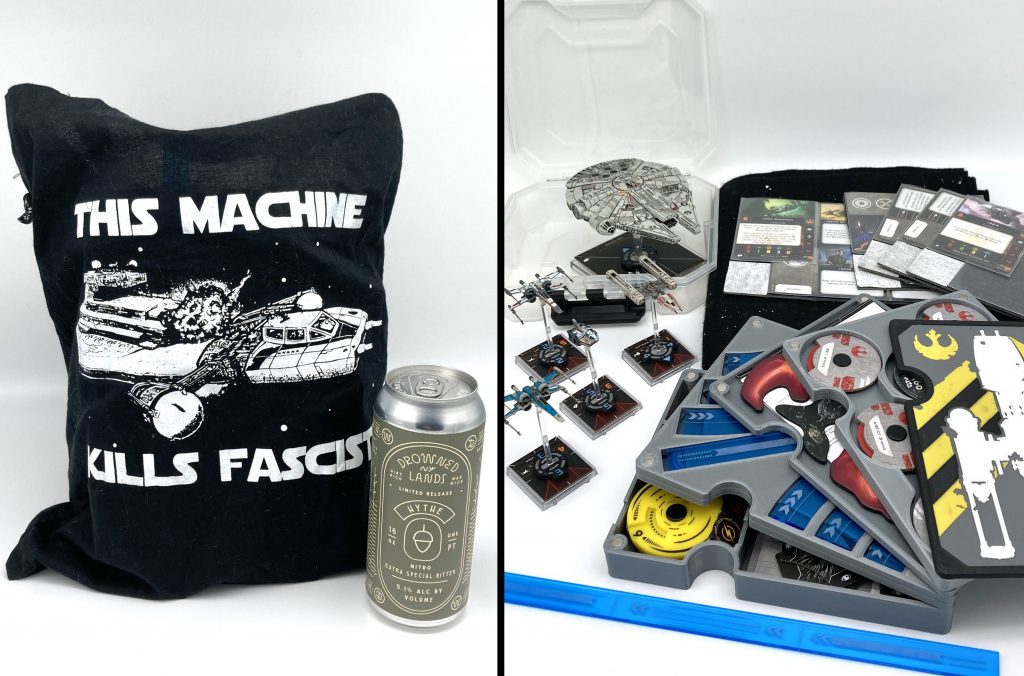
Can I Play As My Favorite Character?
X-Wing currently has seven factions, comprised of the “good guy and bad guy” pairings from each trilogy plus Scum & Villainy, a catch-all faction which includes characters from across the timeline. Between these factions, almost every character of any significance from current canon makes an appearance. This includes the expected main characters from the movies as well as an impressive array of obscure characters from video games, novels, and comics – you can fly Doctor Aphra, Iden Versio, and Ciena Ree from current canon as well as a few fan favorites from Legends, like Dash Rendar, Corran Horn, and Soontir Fel.
Most characters appear as unique pilots, but many also show up as crew members who can lend abilities to carrier ships. Some characters appear in multiple roles like Hondo the pilot, Hondo the crew member, or Hondo the pirate fleet commander for narrative Epic gameplay. Some pilots appear in in various ships and/or loadouts, representing different points in their careers. For example you can fly young Phoenix Squadron Wedge Antilles fresh out of the Imperial Academy, a more experienced Wedge from the Battle of Yavin, ace pilot Wedge at his prime during the Battle Over Endor, or a customizable “adult Wedge” pilot card which you can load out as you please. These options give lots of toys to tinker with for competitive players, but also allow narrative gamers to make thematic squads representing famous engagements.
(Note that most pilot cards are “Custom,” meaning that you can equip them with whatever eligible upgrades you choose. Newer releases have introduced “Standard Loadout” pilot cards which are tarot-size and feature upgrade text printed right on them, representing pilots and their ships as seen at a specific moment in Star Wars history. You cannot modify the upgrades printed on these Standard Loadout pilots, but they feature unique and often strong abilities.)
Below is a broad look at each faction archetype, but it’s worth noting that any faction can be built to suit any playstyle – they all have powerful aces, cheap filler ships, and bulky support craft. If you’re coming into the game a Star Wars fan, it’s best to choose the faction that appeals to you thematically and build your collection from there. Clicking the name of each faction takes you to a fan-maintained X-Wing wiki page, listing all the playable ships for that faction.
- Galactic Republic: The “good guy” faction from the prequel trilogy, Republic squads are primarily made up of Jedi aces backed up by Clone Troopers. Force-powered abilities, rare in most other factions, are common due to the large number of Jedi pilots. Selfless Clone Troopers back up their Jedi Generals with support ships like the LAAT/i “Republic Gunship” and ARC-170 Starfighter, while smaller Clone starfighters provide the bodies needed to accomplish mission objectives. Stars of the faction include Jedi like Anakin Skywalker, Obi-Wan Kenobi, Kit Fisto, and Plo Koon supported by Clones like Captain Rex, Commander Cody, and the famed pilot “Oddball.”
- Separatist Alliance: The “bad guy” faction from the prequel trilogy, the Separatists offer extremely cheap bodies in the form of Droid Fighters. These robotic fighters have unique networking abilities, able to share tokens in a way most living pilots cannot, and often have hard turn maneuvers which are easier than their gentle bank maneuvers – an unusual game mechanic which incentives hard right-angle maneuvers that are simple for artificial minds to calculate but difficult for living anatomy to endure. In addition to exotic Droid Fighters like the Tri-Fighter and HMP Gunship, this faction has famous villains like Darth Maul, Count Dooku, General Grievous, and Jango Fett.
- Rebel Alliance: The “good guy” faction from the original trilogy, the Rebel faction is broadly characterized by positive synergy. Characters often share tokens, absorb hits for one another, and generally serve as all-around positive role models. Their ships tend to be a bit clunky but durable, with the eponymous X-Wing being a solid all-rounder with a bevy of pilots to choose from. The characters are exactly who you would expect – pilots like Han Solo, Wedge Antilles, and of course Luke Skywalker, supported by crew like Chewbacca, Leia, C-3PO, and R2-D2.
- Galactic Empire: The “bad guy” faction from the original trilogy, the Imperial faction features glass-cannon aces and maneuverable TIE Fighter variants that typically die to a good shot or two – provided the enemy can get past their evade dice! The Empire is known for its faceless soldiers, and famous characters like Darth Vader often fly into battle alongside pilots only known by their squad callsigns (such as Sigma 7 or Scimitar 3). Their crew options, however, feature ominous personalities such as Grand Moff Tarkin, the Grand Inquisitor, and Emperor Palpatine himself.
- Resistance: The “good guy” faction from the sequel trilogy, this faction has a little less supportive synergy than the Rebel faction but makes up for it with hot-rodded starfighters. Their upgraded and modernized ships tend to be a bit more durable and maneuverable than their Rebel counterparts, meaning they can operate more independently. Heading up the roster are the expected cast – Poe, Rey, and Finn – but some more mature characters make a reappearance. For example, now-General Leia has the option to helm a slightly rusted and decrepit Millennium Falcon, and she has new Force abilities which were absent during her days with the Rebellion.
- First Order: The “bad guy” faction from the sequel trilogy, the First Order is a similarly upgraded take on the Imperial faction. Even the basic TIE/fo Fighters now have shielding, and the faction’s emphasis is on fanaticism rather than expendability. While Imperial ships will dutifully die for the Empire, First Order ships will often get benefits for suffering damage or straining themselves in service of their Supreme Leader. Kylo Ren is the faction’s undisputed ace, and characters like Captain Phasma also take the pilot’s seat while Supreme Leader Snoke and General Hux crew the faction’s shuttles and transports.
- Scum & Villainy: The Scum faction is an era-agnostic catch-all bucket for everything that doesn’t fit neatly into one of the options above. It of course includes the classic bounty hunter lineup (Boba Fett, Bossk, Dengar, IG-88, etc.), but also includes pre-Rebellion versions of lovable scoundrels like Han, Lando, and Dash Rendar of Legends fame. The faction also boasts an extensive roster of Mandalorian ships and characters, from popular Clone War and Rebels animated series characters to Din Djarin himself. As you might expect, Scum is the faction of dirty tricks and back-stabbery. They can steal tokens from each other, snort space drugs for short-lived advantages, detonate upon death, and even gain the rare ability to fire upon their allies (to strategically trigger a friendly Deadman’s Switch and damage multiple enemies, for example).
- Hondo Ohnaka: While not a faction, it’s worth noting that Hondo is the only named crew member who is completely faction-unaligned and can be included in any squad from any era. His ability is also hilarious, representing his knack for sweet-talking his way out of a situation or distracting an enemy while pulling off some underhanded trickery at the same time (by granting one enemy pilot an extra action, then denying an action to another). Big props to the game designers for capturing this cheeky rogue’s opportunistic energy, and letting him weasel his way on board with any enterprise.
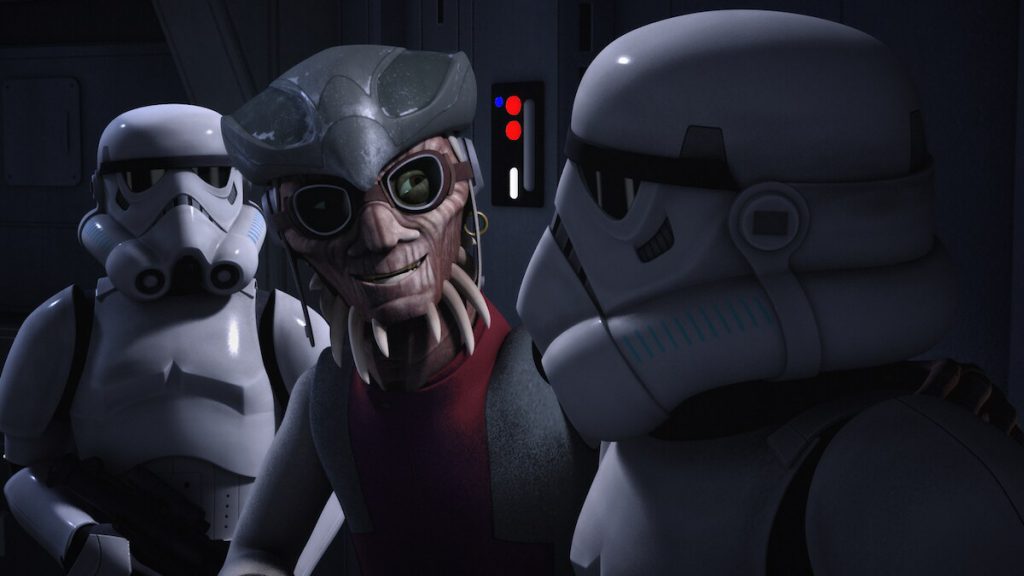
The State of the Game
First released in 2012, X-Wing had a period of enormous popularity – according to ICv2, it beat out Warhammer 40,000 for the title of top-selling miniature game in 2016. Not many games have that claim to fame!
Unfortunately the transition to Second Edition in 2018 – while being an enormous improvement to gameplay – lost many players who were new to the idea of having their old game materials invalidated by an edition change. When Atomic Mass Games took the game over from Fantasy Flight Games in late 2020, the one-two punch of a semi-new edition (commonly called “2.5”) and a reduction in game support under the new management took a further toll on the player base. The global pandemic around that time didn’t help, either!
The release of new product slowed dramatically under Atomic Mass Games, with the studio’s attention focused on their own flagship game and the new release of Shatterpoint. Eventually, in a move that many were expecting, AMG announced the end of support for the game in a post on June 13th, 2024. The announcement cited “rising production costs, global manufacturing, and pandemic-related challenges” as reasons for the decision to end official support.
Despite this, AMG’s brief tenure left the game in a better place than they found it. The introduction of mission scenarios to standard and competitive play was long overdue for a game that had previously been limited to “line up and kill each other,” and dedicated scenario expansion products like Battle of Yavin introduced ways for players to reenact iconic engagements from the Star Wars universe. If X-Wing support ever had to lapse, it happened at a good time for players to have ample content to explore and enjoy well into the future.
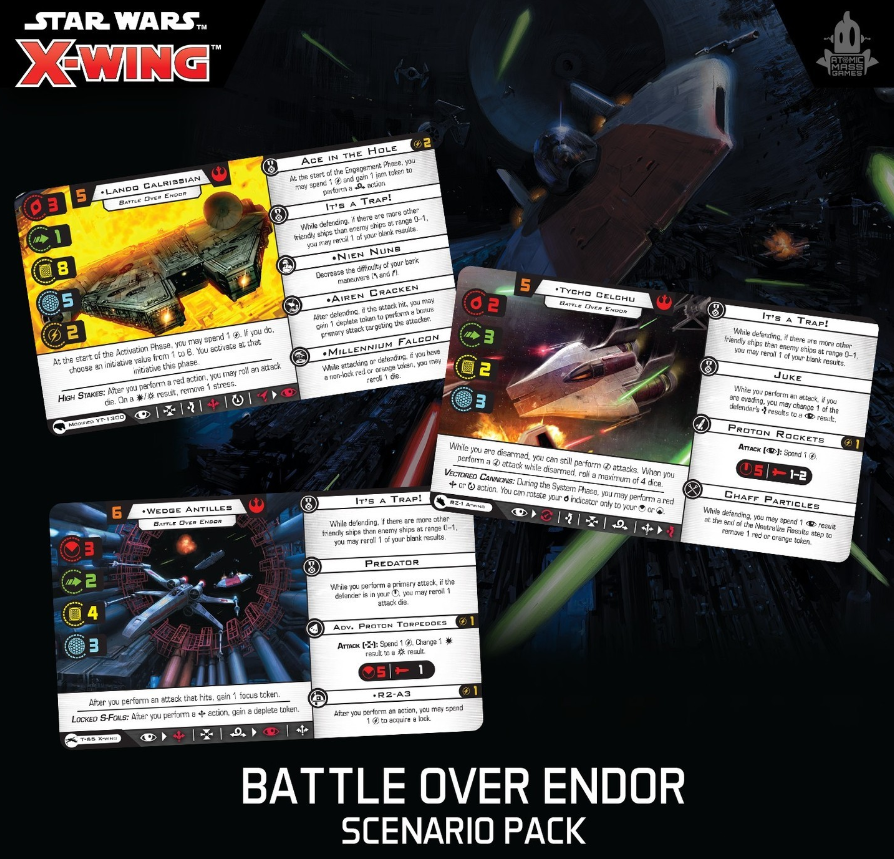
What You Need to Play
Like many miniatures games, there are multiple ways to play X-Wing. This section introduces those various ways, and tells you what you need to purchase for each one.
Standard Play
The most common way to play X-Wing is called Standard Play, and it is used for most tournaments and game store pick-up games. This game type only uses ships released since the game’s Second Edition, has a fixed game size, and is limited to four scenarios designed for well-balanced competitive play. All the other ways to play – Extended, Scenario, and Cooperative – build upon the essentials required for Standard Play. Here are those essentials:
- Core Game Materials: It is easiest to get into the game with a starter set like the two-player Core Set, or the Galactic Empire Squadron or Rebel Alliance Squadron starter boxes. These contain all the templates, dice, and damage cards you need to play the game. If you choose not to purchase a starter set, you can purchase the templates, dice, and damage cards (with cosmetic card designs for each faction) separately.
- Rules: All the rules needed to play X-Wing – core rules, errata, and ship/upgrade points – are available for free as online PDFs. Several free fan-made applications exist to make squad building easy, most notably Launch Bay Next and Yet Another Squad Builder. The website Infinite Arenas offers a tool to beautifully condense your pilots and all of their upgrades into very convenient tarot-size cards, which resemble official Standard Loadout cards. Many people print these, cut them out, and use them in both casual and competitive play. If you’re playing casually, this easy “print and play” option frees you from having to buy expansions just to get new cards – but if you’re going to a formal tournament, be sure to carry copies of the official cards with you!
- Game Mat: Standard X-Wing is played on a 3’ x 3’ playing area, and most players use neoprene mats to define that space. Official versions are available as well as countless Etsy stores producing their own. If you want a cheaper, lighter, and more compact option to get started, you can simply purchase a plastic “starry sky” tablecloth for a few bucks and neatly cut out a 3’ square. A black square of felt or fabric also works well.
- Additional Ships: You will want to expand your starter box with a few additional ships (available here), to have more ship variety and upgrades at your disposal. In organized tournament play, purchasing certain ships may be the only way to get specific upgrade cards. While X-Wing is a well-balanced game and victory usually comes down to the superior player, the website MetaWing can be used to identify trends in the competitive environment and inform purchases if you intend to enter the tournament scene.
- OPTIONAL – Fancy Gaming Components: It’s extremely common to see people playing with laser-cut acrylic maneuver templates and tokens, or 3D-printed cases to organize and transport their materials. These are not at all necessary to enjoy the game, but if interested the most common brands are CurledPawCreatives and BuyTheSameToken.
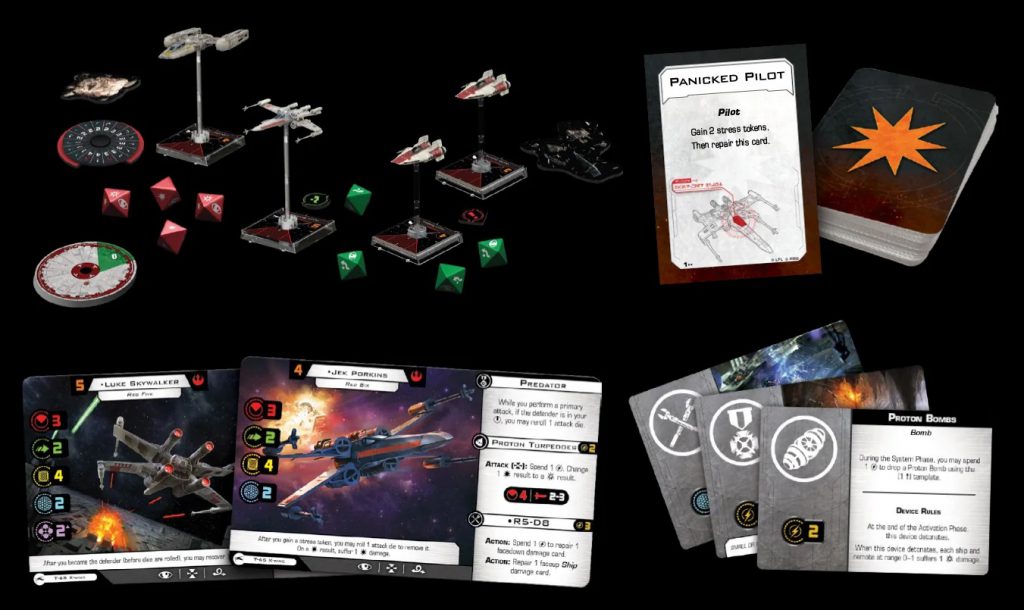
Extended Play
This game type is largely identical to Standard Play, but introduces the option to use ships from the game’s First Edition. As of the time of writing, iconic ships like the Imperial Lambda-Class Shuttle and the Rebel E-Wing – recently reintroduced to canon via the Ahsoka show – have not been released in Second Edition, so Extended is the only way to fly them. The popularity of Extended varies on the local community, and in many areas players will have no problem flying their Standard Squad against another player’s Extended squad. Note that Extended is generally played by players who want to use all the ships in their old First Edition collection – if you are just getting into the game, you should probably ignore this game mode and stick with Standard Play.
Note that some upgrade cards are also restricted to Extended. While most people have no problem playing against Extended ships, some of the Extended upgrade cards are seen as unbalanced or negative play experiences. Unless you are going to an explicitly Extended event or gaming group, probably best to avoid those upgrades.
- First Edition Ships: If you’re playing Extended you probably want some fun Expanded Universe ships, like the Imperial TIE Phantom (of Rebel Assault II fame) or the ludicrous Rebel K-Wing. These old out-of-print First Edition items are usually easiest to find on eBay at this point, or – since the cardboard is obsolete and you’re just looking for the model – you can purchase them from a 3D print shop and paint yourself.
- Conversion Kits: Fantasy Flight Games released Conversion Kits with all the necessary cardboard pilot cards, bases, dials, and upgrades you will need to fly First Edition ships in Second Edition. You can either buy the full kit for your faction of choice, or look for eBay sellers who are offering parceled-out components for the specific ships you need.
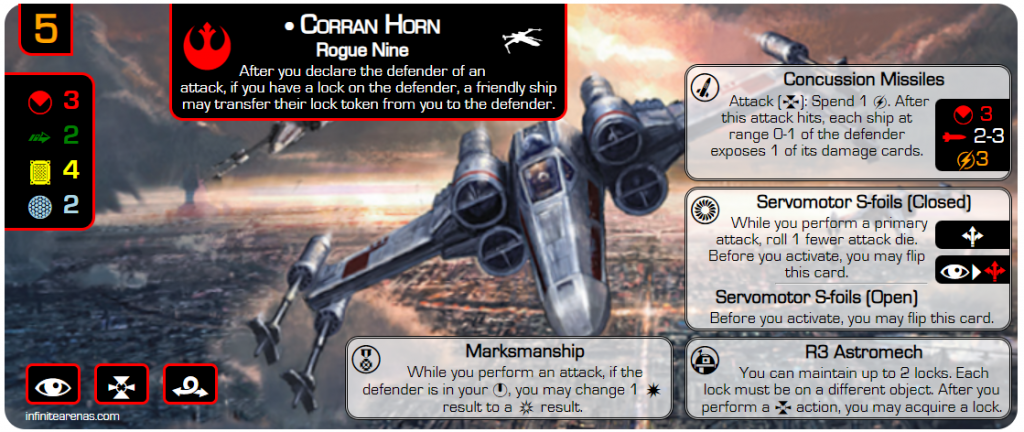
Scenario Play
The core game of X-Wing is balanced around four scenarios used in competitive play, but there are products to support much more varied and narrative options.
- Scenario Packs: These sets feature cinematic missions and rules based on pivotal movie events like the Battle of Yavin, Siege of Coruscant, and Battle Over Endor. They include Standard Loadout cards which lock pilots into specific upgrades, sacrificing their normal flexibility for exciting new abilities. These Standard Loadout cards are legal in Standard Play, making scenario packs valuable even for people only interested in competitive play.
- Environment Cards: The expansions Fully Loaded and Never Tell Me The Odds include rules for fighting in different environments, from ionizing gas clouds to Mynock-infested asteroids to minefields of unexploded ordnance. These environments can be randomly drawn or intentionally chosen in addition to standard scenario rules, and are an easy way to spice up your games.
- Epic Battles: The Epic Battles expansion introduces new ways to play, from small one-ship-per-player party games like Aces High to massive all-day multiplayer and team scenarios. For players who come from games like Warhammer 40,000 and want to see that kind of game length/scenario complexity in X-Wing, this is the expansion for you.
- Huge Ships: While not necessary to play Epic Battle scenarios or larger games, Huge Ships are fun! They offer new ways of maneuvering and energy-management decisions that make you feel like the bridge commander of a suitably hefty ship and its crew. Second Edition saw the release of the Tantive IV, C-ROC Cruiser, and Trident-class Assault Ship huge ships, but any older Huge Ships (like my personal favorite Gozanti Imperial Assault Carrier) will require the Huge Ship Conversion Kit. Note that the current edition of the game does not have official point values for Huge Ships or upgrades, but YetAnotherSquadBuilder provides unofficial point values for Epic play. Epic is inherently a casual format, so this should be fine with most players.
- Organized Play Kits: Various scenario kits with bespoke rules are available to local game stores, and players can often purchase them on eBay. Examples include “The Droids You’re Looking For” (often referred to as “droid soccer,” or “X-Wing Rocket League”) and Children of Mandalore.
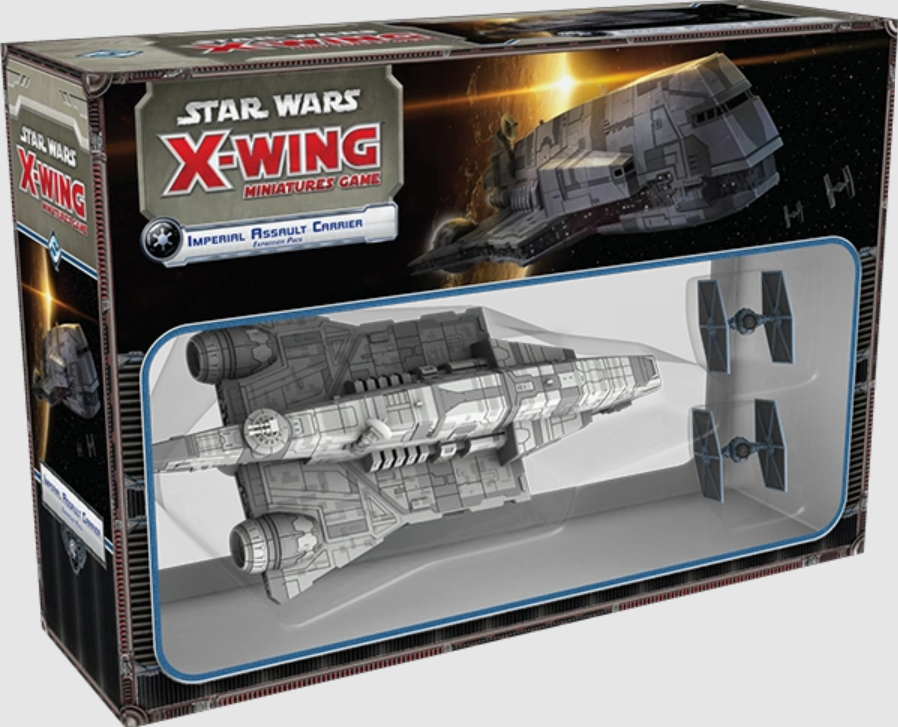
Cooperative Campaign and Solo Play (Fan-Made)
Last but certainly not least, several fan-made X-Wing expansions exist for cooperative and progressive campaign play or solo “AI enemy” play. This is an incredibly fun way to play, and highly recommended – while you can play solo against AI enemies, cooperative play is also the perfect way to bring your more casual friends, spouses, or children into the action. Goonhammer has an article on the most famous of these cooperative expansions – Heroes of the Aturi Cluster – to get you started. If you want to fly against enemies in standard dogfights, the X-Wing AI app is a fantastic resource that accommodates every ship in the game.

Final Notes
If it wasn’t clear after reading this far, I adore X-Wing. It remains my favorite game of all time for the way it combines strong thematic elements with balanced gameplay, mathematical precision with gut-based maneuvering, tactics with bluffing, and expansive options with simple game mechanics. In almost every way, X-Wing is the perfect game.
I hope you decide to lock your S-Foils in attack position and give it a go. Happy flying!
Have any questions or feedback? Drop us a note in the comments below or email us at contact@goonhammer.com.


